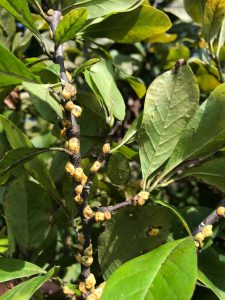Do you notice a large number of bees or wasps visiting your magnolia tree? Do you see “bumps on the twigs”? Are the leaves and branches turning black? It is probably Magnolia or Tuliptree scale.
These scale belongs to a group of insects referred to as soft scales. Scale insects feed by inserting their piercing-sucking mouthpart into the plant’s vascular system and removing sugar and water from the tissue. As the insects feed the fluids become concentrated in the gut of the scale, forcing them to excrete a clear, sticky liquid called honeydew. The honeydew drips onto the leaves, stems and anything else below. Honeydew serves as a growth media for sooty mold, the thin layer of black fungus that forms on the surface. The honeydew is a food source for other insects, like bees and wasps. But, the sooty mold prevents sunlight from reaching the leaf surface, preventing photosynthesis from occurring.
Scales are identified by their body covering. Magnolia scale (Neolecanium cornuparum) is one of the largest soft scale, measuring up to ½ inch in diameter. They range from pink-orange to dark brown in color and are often covered with a white wax at maturity. Tuliptree scale (Toumeyella liriodendri) is a similar appearing scale that can infest magnolia species. But, it does not form the white wax.
Magnolia and Tuliptree scale reaches maturity in August with one generation per year. The female lays her eggs, which hatch internally and form crawlers that move from under the body covering and migrate to the underside of small twigs, where they will spend the winter. Once settled in, the young scales begin to feed and never move again, growing larger in the same spot.
Now is the time to take action. For small trees, the scales can be removed by hand with a soft brush. Horticultural oil will smother adults and crawlers, if the trees to be treated are larger or time is limited. Systemic insecticides can be applied for lasting effects. Imidacloprid is a pesticide that can be applied as a soil-drench, reducing the potential for harm to pollinating insects. In the fall, insecticidal soap can be applied to control the crawlers that hatched. Plan on treating the tree again next year. Scale population suppression usually requires at least two years of pest management. For more information on scale insect management go to: https://edis.ifas.ufl.edu/pdffiles/MG/MG00500.pdf
- Watch for “Melting Grass” - February 19, 2025
- Palms Can Suffer in the Cold - January 30, 2025
- Camellia Care - January 9, 2025

